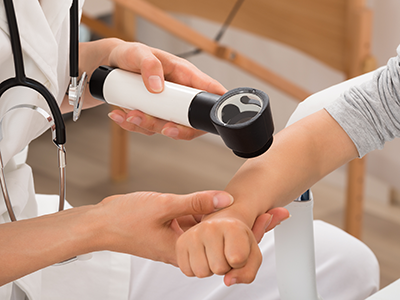Moles on children’s skin are usually nothing to worry about. As kids get older, they may develop moles after spending time in the sun, and as children grow, their moles may get bigger in size. Moles can also darken or lighten or even fade away. However, occasionally a mole is more than just a mole, and could be skin cancer, or melanoma. Spotting the difference can be challenging, but the following information can help you decide if your child’s mole needs to be examined by a dermatologist.
What do normal moles look like?
Normal moles look like small, dark spots that are about the size of a pencil eraser. They can be present during birth but it’s more common for them to appear during childhood or young adulthood. Moles may change color over time and usually appear symmetrical. Generally, fair-skinned people develop more moles than darker-skinned people.
Signs your child’s mole needs to be checked by a dermatologist
- The mole changes rapidly: If your child’s mole is growing or changing rapidly and these changes are causing the mole to look different from other moles on their body, they should see a dermatologist.
- The mole is dome-shaped, has a jagged border or contains different colors: A raised, round mole that is pink, red, tan or brown could be cause for concern.
- The mole bleeds: If the cause of the bleeding is not due to irritation (for example the mole catches on something), a dermatologist should check the mole.
- There are many moles: It’s normal for a child to have anywhere from 10 to 20 moles, but if they have more than 50 moles, they should be under a dermatologist’s care.
- The mole is very large: Most moles are no bigger than a pencil eraser. Having a much larger mole can increase a child’s risk of developing melanoma.
How to protect your child from skin cancer
- Wear sun protection and use a broad-spectrum sunscreen that is SPF 30 or higher. Try to keep your child out of the sun for extended periods of time to avoid severe sunburn.
- Do regular mole checks and document everything. It’s important to get into the regular habit of checking your child’s moles yourself and teaching them to get to know their moles as well.
- Contact a dermatologist if you see a mole that does not look right. If detected early, skin cancer is highly treatable!
 https://riseandshine.childrensnational.org/wp-content/uploads/2018/08/girl-with-stuffed-rabbit-looking-out-window-feature.png
300
400
Rise and Shine
https://riseandshine.childrensnational.org/wp-content/uploads/2017/11/childrens_riseandshine_logo.jpg
Rise and Shine2024-09-23 07:00:292025-09-02 14:26:41When your child’s friend has cancer
https://riseandshine.childrensnational.org/wp-content/uploads/2018/08/girl-with-stuffed-rabbit-looking-out-window-feature.png
300
400
Rise and Shine
https://riseandshine.childrensnational.org/wp-content/uploads/2017/11/childrens_riseandshine_logo.jpg
Rise and Shine2024-09-23 07:00:292025-09-02 14:26:41When your child’s friend has cancer







Leave a Comment
Want to join the discussion?Feel free to contribute!